Joshua Bittle
Associate Professor
Department of Mechanical Engineering
Associate Director – Center for Advanced Vehicle Technologies
https://jbittle.people.ua.edu
https://scholar.google.com/citations?user=dEM8ysoAAAAJ&hl=en
Ajay K Agrawal
Robert F. Barfield Endowed Professor
Department of Mechanical Engineering
https://scholar.google.com/citations?hl=en&user=IogAX3cAAAAJ
https://Agrawal.people.ua.edu
Students:
In diesel engines and aviation gas turbines, liquid fuel is injected into an oxidizer ambient at relatively high temperatures and pressures. High Pressure Sprays lab has unique capabilities to study fuel-air mixing, combustion, and emissions, especially soot formation, at realistic engine conditions. Our research has focused on (a) developing and applying novel optical diagnostics techniques at these harsh engines condition, (b) understanding and quantifying fuel effects on diesel combustion including soot formation, and (c) fuel-air mixing at supercritical conditions when surface tension and hence, two-phase spray phenomena is no longer present. We have focused mainly on intermittent combustion for diesel engines, but continuous combustion studies related to high-pressure gas turbines are also feasible with modifications.

Test conditions are maintained continuously in optically accessible constant pressure flow rig (CPFR). Compressed air from a high-pressure compressor is stored in pressurized gas cylinders at a pressure of over 150 bar, serving as buffer, to supply air continuously to the test chamber. Air is electrically preheated to the desired temperature before it enters the chamber and exhausts at the top with restrictions in place to control the pressure within the chamber. Fuel at supply pressures of up to 2000 bar is injected downwards from the top of the chamber into the slow-moving air flow using a Bosch CRIN3-18 injector modified to have a single 104 μm orifice at the tip.
Two CFFR systems are available:
- First generation CFPR system has maximum ambient pressure of 50 bar and temperature of 850 C.
- Second generation CFPR system has maximum ambient pressure of 150 bar and temperature of 1050 C.
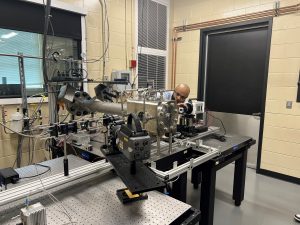

Steady thermodynamic conditions are maintained within the chamber and hundreds of repeated fuel injection experiments without or with combustion can be performed in quick succession to acquire statistically significant data. Fuel-air mixing, autoignition, and combustion phenomena are viewed through two parallel 100 mm diameter quartz windows using high-speed optical diagnostics.
Optical Diagnostics. High-pressure reacting sprays in diesel engines have three distinct phenomena; (a) liquid fuel injection, fuel evaporation, and fuel-air mixing in the near field, (b) autoignition followed by quasi-steady flame stabilization at the lift-off length, and (c) combustion and soot formation in the downstream flame zone. In conjunction with Gas Turbine Combustion laboratory, we focus on developing and implementing novel optical diagnostics techniques to quantify various zones of high-pressure sprays.

For the first time, we have successfully applied Rainbow Schlieren Deflectometry (RSD) to study high-pressure reacting sprays. With RSD, both first stage and second stage ignition processes can be visualized which is difficult with the conventional black-and-white schlieren approach. RSD has also proven effective to simultaneously quantify both liquid length and vapor length by a single diagnostics technique. Typically, liquid length is measured by Mie scattering and vapor length is measured by Rayleigh scattering and these two techniques must be used separately to avoid the signal interference between them.
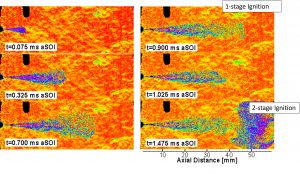
We have developed a novel two-color pyrometry (2CP) setup using off-the-shelf optics to eliminate parallax and optical path length errors introduced in existing systems. This capability makes it possible to acquire spatially resolved line-of-sight soot temperature and/or soot concentration in diesel flames using a high-speed camera. Radiative emission from soot particles is related to soot temperature, but emissions data at two distinct wavelengths are necessary to determine the emissivity; wavelengths of 550 nm and 650 nm are used to avoid specific band emissions from radical species. A single camera acquires two images, one for each wavelength, such that each image pixel in each image represents the same view angle or line of sight and the same optical path.

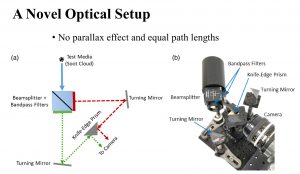
Building upon the 2CP technique pioneered in this lab, we have developed a versatile optical setup to image any two different combustion species using a single high-speed camera. Simultaneous Chemiluminescence (CL) Imaging of multiple combustion species requires an image doubler or a beam splitter, which inherently introduces parallax and/or path-length errors in the image produced. Multiple cameras, each viewing a different species, also introduce parallax and line-of-sight (LOS) errors because each camera has a different view angle.
The technique provides spatially resolved measurements of multiple CL species in reacting flows. As in the 2CP technique shown above, broadband CL signal from the test media is split by a beamsplitter oriented perpendicular to the camera lens for light collection and then, filtered and routed in two different directions before reaching separately towards the camera. This arrangement enables the two sub-images to be symmetrically divided onto the camera lens. Light from the beam splitter passes through two narrow bandpass filters, with transmissivity peaks at the emissivity wavelength for each species observed.
Diesel Combustion. It is well known that no two injection experiments are the same, and significant injection to injection variations occur in practice. We have developed a methodology to classify individual injections and then, identify a most representative single injection to compare effects of operating conditions and/or fuel blends. The analysis is based upon z-score of user defined parameter(s). The z-score measures the departure of a parameter from its average values and can be normalized and weighted to combine results from different diagnostics. This approach quantifies and describes the range of variations in a phenomenon to a degree impossible to identify with ensemble average analysis. This work is published as:
- Parker, A., Agrawal, A. & Bittle, J. Representative Phenomena of Cyclic Turbulent Combustion in High-Pressure Fuel Sprays. Flow Turbulence Combust 111, 675–696 (2023).
We have applied the above diagnostics techniques to understand in-cylinder processes in diesel engines to help screen emerging biofuels and advanced combustion modes. Specifically, the role of fuel properties on spray development and combustion has been investigated by systematically isolating fuel’s chemical and thermophysical properties. Using RSD, OH* CL, and 2CP techniques, we determined liquid length, vapor penetration length, timing and location of first stage and main ignition events, lift-off location, total soot mass, and more, in hundreds of consecutive injections for diesel combustion to ensure statistically significant data.
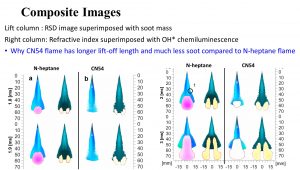
Results show that fuels with similar chemical properties or cetane number (CN) exhibit similar delay times for first stage and main ignition events as expected, but very different liquid length, first stage and main ignition locations, lift-off length, apparent turbulent flame speed, and soot formation. We find that fuel’s thermophysical properties affect the liquid length which is an important contributing factor for lift-off length and soot emissions from the combustion process.
- Parker, A., Reggeti, S.A., Bittle, J.A. and Agrawal, A.K., 2023. Limitations of cetane number to predict transient combustion phenomena in high-pressure fuel sprays. Combustion and Flame, vol. 251, p.112723.
Sooting behavior of diesel spray flames is difficult to quantify during the quasi-steady period. We have applied spatially resolved 2CP technique to study these flames at ambient thermodynamic conditions that are slightly below those in modern diesel engines. Detailed measurements show and affirm that the soot formation in the lift-off region is small, but appreciable soot forms in the jet core and jet head regions, while it oxidizes gradually on the jet periphery. Total soot mass profiles indicate that regions with larger local soot mass take longer to form but are the first to oxidize. Probability distributions of soot mass in localized regions indicate that a few injections with high soot mass bias the average soot mass data towards higher values. These results provide difficult to acquire statistical details of transient and localized soot behavior in high-pressure diesel spray flames which can support related modeling efforts. Figure below shows the average combustion behavior at select time steps; planar OH∗CL signal in the top row, soot mass in the second row, soot temperature in the third row, and soot mass rate in the fourth row.
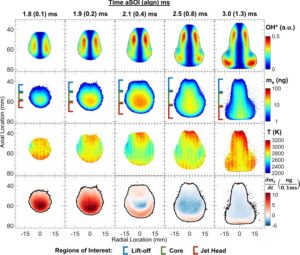
Supercritical Mixing. Increasing fuel temperature and chamber pressure in diesel engines and gas turbines can result in fuel-air mixing at supercritical conditions, i.e., above the critical point of fuel and fuel-air mixture thus formed. The surface tension vanishes at these conditions, and thus, fuel spray and associated two-phase phenomena will longer be present. Thus, fuel-air mixing will be purely diffusive in nature, replacing the time-consuming droplet breakup, evaporation, and mixing processes. It is hypothesized that the time scales of a purely diffusive mixing process can be much shorter compared to the typical spray processes and the resultant mixture could avoid combustion in diffusion mode to reduce emissions of NOx, CO, and soot. Our experimental facilities are capable to support supercritical mixing studies in conjunction with parallel Modeling & Analysis efforts. We have studied transient, near-field mixing of a supercritical fluid injected into supercritical and subcritical environments. Fuel (propane) from a 100-micron diameter Bosch diesel injector was injected into HPFR with a steady flow of heated, low-velocity nitrogen to control the ambient pressure and temperature. Microscopic RSD is used for visualization and quantitative data acquisition. In case of the supercritical ambient, RSD analysis revealed a single-phase fluid process, although retrograde condensation predicted by the adiabatic mixing theory was also present. For the subcritical ambient case, rapid expansion in the near field promoted mixing between propane and nitrogen.
Research Examples:
- From Optical Spray Diagnostics to Peripheral Fuel Injection (PeFI): Advancing Diesel Combustion for High-Efficiency and Low-Emissions
- Sooting behavior of commercial and bio-derived butyl-acetate/n-heptane blends in high-pressure spray combustion experiments
- Simultaneous Imaging of OH* and CH* Chemiluminescence in the Exhaust of a Rotating Detonation Engine
Related Publications:
Journal:
- Shawn A. Reggeti, Allen Parker, Anna Stevenson, Ajay K. Agrawal, Joshua Bittle, 2024, “Spatially resolved soot evolution and statistics in high-pressure diesel spray flames using two-color pyrometry,” Combustion and Flame. Volume 261, Paper 11329.
- Harris, Zack, Bittle, J., and Agrawal, A.K., 2024, “Fuel Injector Requirements to Achieve Supercritical Flow at the Exit,” AIAA Journal of Propulsion and Power, https://doi.org/10.2514/1.B39265, Nov 2023.
- James, A.M., and Agrawal, A.K., 2023. Spatially resolved chemiluminescence imaging of multiple combustion species using a single high-speed camera. Measurement Science and Technology, 34(12), p.125305.
- Parker, A., Agrawal, A. and Bittle, J., 2023, “Representative Phenomena of Cyclic Turbulent Combustion in High-Pressure Fuel Sprays,” Flow, Turbulence and Combustion, 111(2), pp.675-696.
- Wanstall, C.T., Bittle, J.A. and Agrawal, A.K., 2023. Phase diagram to demarcate supercritical, transcritical, and continuous phase regimes for binary fluid equilibrium mixing relevant to combustion applications. The Journal of Supercritical Fluids, 199, p.105935, featured article for August 2023 issue of the journal.
- Parker, A., Reggeti, S.A., Bittle, J.A. and Agrawal, A.K., 2023. Limitations of cetane number to predict transient combustion phenomena in high-pressure fuel sprays. Combustion and Flame, vol. 251, p.112723.
- Reggeti, S., Agrawal, A.K. and Bittle, J., 2022, Robust Two-Colour Pyrometry Uncertainty Analysis to Acquire Spatially-Resolved Measurements, Measurement Science and Technology, 33, 125201 (13pp),
- Wanstall, C.T., Bittle, J.A. and Agrawal, A.K., 2022, Transient mixing behavior of a supercritical fluid injected into supercritical and subcritical environments, Physics of Fluids, 34(2), p.023104.
- Harris, Z., Bittle, J. and Agrawal, A., 2022, Role of Inlet Boundary Conditions on Fuel-Air Mixing at Supercritical Conditions. Journal of Energy Resources Technology, 144(6), p.062302.
- Reggeti, S.A., Parker, A., Wanstall, C.T., Agrawal, A.K. and Bittle, J.A., 2021, Comparing Global Spray Combustion Characteristics and Local Shot-to-Shot Variations in a Reacting n-Heptane Spray, Journal of Engineering for Gas Turbines and Power, 143(9), p.091018.
- Wanstall, C.T., Bittle, J.A. and Agrawal, A.K., 2021, Quantitative Concentration Measurements in a Turbulent Helium Jet using Rainbow Schlieren Deflectometry, Experiments in Fluids, 62(3), pp.1-13.
- Parker, A., Wanstall, C., Reggeti, S., Bittle, J., and Agrawal, A.K., 2020, Simultaneous Rainbow Schlieren Deflectometry and OH* Chemiluminescence Imaging of a Diesel Spray Flame in Constant Pressure Flow Rig, Proceedings of the Combustion Institute, 38(4), pp.5557-5565.
- Christopher Wanstall, C. T., Agrawal, A. K., and Bittle, J. A., 2020, Implications of Real-Gas Behavior on Refractive Index Calculations for Optical Diagnostics of Fuel-Air Mixing at High Pressures, Combustion and Flame, 214, pp.47-56.
- Christopher Wanstall, Henning Junne, Joshua A. Bittle, and Ajay K. Agrawal, 2019, A Robust Statistical Algorithm for Boundary Detection in Liquid Sprays, Atomization and Sprays, 29(12).
- https://10.1615/AtomizSpr.2020032584
- Reggeti, S. A., Agrawal, A. K., and Bittle, J. A., 2019. Two-color pyrometry system to eliminate optical errors for spatially resolved measurements in flames. Applied Optics, 58(32), 8905-8913.
- Christopher Wanstall, C. T., Agrawal, A. K., and Bittle, J. A., 2019, Phase boundary detection in transient, evaporating high-pressure fuel sprays by rainbow schlieren deflectometry. Applied Optics, 58(25), 6791-6801.
- Agrawal, A.K., and Wanstall, C.T., 2018, Rainbow Schlieren Deflectometry for Scalar Measurements in Fluids Flows, Journal of Flow Visualization and Image Processing, 25(3-4).
- Wanstall, C.T., Agrawal, A.K. and Bittle, J.A., 2017. Quantifying liquid boundary and vapor distributions in a fuel spray by rainbow schlieren deflectometry, Applied Optics, 56(30), pp.8385-8393.